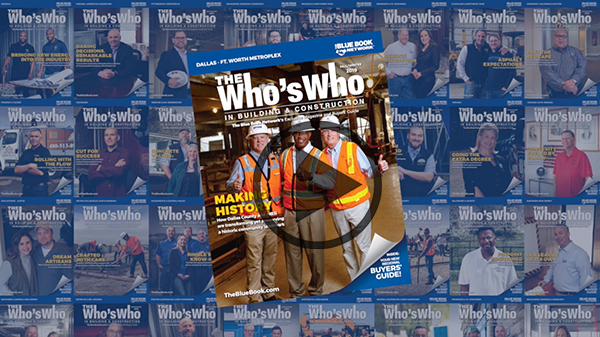 Cover Story
Cover Story
Making History
How Dallas County and MB3i are transforming yet preserving a historic community landmark

Martin Lehman (left), Micheal Williams and Bob Bowen stand in the first-floor, main-entry corridor in what was known as The Records Building. Exposed structural steel is visible in addition to part of the original ceiling that will remain in place. The elevators for The Records Building used to be located just left of the men.

An exterior view of the southwest side of The Records Building Annex (built in 1955). The intricate steel braces anchored from the fourth floor to the roof are temporarily supporting the building’s structure.
It’s not every day that a construction project proves capable of inspiring a local community. “Exciting,” “historic,” “one-of-a-kind” and “part of the community’s DNA” are just a few of the words and phrases that Dallas County community leaders and citizens have used to describe the Dallas County Records Building (DCRB) renovation project currently underway in the heart of downtown Dallas.
Historic Landmark
A historically designated landmark at the local, state and federal levels, the DCRB, collectively known as the Complex, is comprised of three buildings totaling 352,896 square feet: The Old Criminal Courts Building (built in 1915), The Records Building (built in 1928) and The Records Building Annex (built in 1955). History was made, quite literally, both inside and outside the walls of the Complex.
Just east of Dealey Plaza, President John F. Kennedy’s motorcade passed the DCRB minutes before his assassination. In 1935, Sarah T. Hughes held court in The Records Building Annex. She was the first female district judge in Texas and the woman who swore in Lyndon B. Johnson after President Kennedy’s assassination. In 1964, Jack Ruby was tried for the death of Lee Harvey Oswald in the First Criminal Court Courtroom (today known as the Ruby Courtroom) and from 1964 to 1967, Ruby was detained in The Old Criminal Courts Building jail.
“The Complex has existed for over 100 years, and throughout its history, so many people have formed a connection,” says Assistant County Administrator Jonathon Bazan, the county executive charged with project oversight. “Beyond the iconic people and events associated with the DCRB, Dallas citizens used to come to the Complex to get their birth certificates, marriage licenses and death certificates. I quickly realized this endeavor would prove much more than a typical county project.”
Elected project sponsor and Dallas County Commissioner Dr. Elba Garcia says, “It has been amazing to see how many people follow this project. I consistently hear from constituents who drove past the building downtown or read about the renovation and want to know its status. Just last week, I received a phone call from a woman who noticed the construction. In a panic, she asked, ‘Did you change your mind and decide to demolish the Complex?’ ”
The Beginning
The DCRB renovation is scheduled for completion in fall 2020; however, conversations about the project began as early as 2014 with questions about how to effectively utilize county space and create a quality work environment for county employees. The Dallas County Commissioners Court formed a building study committee to decide the future of the DCRB Complex, a decision that removed politics from the equation and involved the public from day one.
“Everything was on the table for the committee—build a new government center on a different site, restore, sell or lease the current Complex,” Garcia says. The result? The committee—comprised of local citizens with expertise in topics ranging from bonding and real estate to administration and construction—recommended in July 2015 that the DCRB be renovated to better utilize the space, preserve its rich history and keep more than 600 county employees working in downtown Dallas.
“For years, the county devoted millions of dollars to maintaining a complex that was dated and in need of serious repair,” Garcia says. “The timing was right to proceed with the committee’s recommendation. It was as if the stars aligned for the project to begin.” The Commissioners Court voted unanimously to proceed according to the committee’s recommendation to preserve an integral part of the community and create a better building.
Despite the project’s $200 million-dollar price tag, constituents’ taxes have and will remain stable, and the county will again prove debt free as early as 2025, all while maintaining its Moody’s AAA bond rating.
Layers of Complexity
Though the DCRB renovation project is enthusiastically endorsed by the community and seemingly fated to succeed, renovating the Complex is no easy task. “Each project has its own set of challenges; however, this project has more than most,” Bazan says. “So many variables must be considered when modernizing three buildings near or over 100 years in age.”
For example, because each building was constructed during a different era, the buildings’ existing floor levels are misaligned. The county enlisted recognized structural engineering firm Datum Engineers, Inc. to design a system that would permit the demolition of the current and installation of a new Complex core while maintaining the buildings’ historic facades. An intricate bracing structure comprised of 180 tons of steel trusses is now anchored to the exterior of the Complex to temporarily support its structure.
Other challenges include: DCRB’s downtown setting creates safety and logistical issues ranging from transporting materials to finding parking for workers; its buildings are historic, which means the county must comply with a variety of local, state and federal regulations; due to the structures’ ages, there are unknown building conditions that may only be treated on an as-discovered basis; the necessary abatement of significant quantities of asbestos and lead paint poses environmental concerns; the systematic removal and partial preservation of a stacked jail structure located six floors above the ground floor of The Old Criminal Courts Building is a delicate, labor-intensive process.
The Team
With a project of this size, scope and complexity, selecting the right professional services and contractors to execute the job is imperative. “We held a competitive procurement process and are very pleased with the core team leading the DCRB renovation,” Bazan says. “We spoke with many great industry leaders during the solicitation process, but the companies we selected rose to the top and proved the best fit for this unique project.”
Broaddus & Associates and Pritchard Associates joined forces to fulfill the role of program manager and owner’s representative; Gensler is the project architect and design team; and Manhattan Construction Company, Byrne Construction Services and 3i Contracting LLC formed a joint venture, MB3i, to fulfill the construction manager role.
"Collaboration between the county and MB3i has proven key to navigating the complexities of this project. We’ve truly worked as a team.” Bob Bowen, Senior Vice President, Manhattan Construction Company
Three is Better Than One: MB3i
For Bob Bowen, Senior Vice President of Manhattan Construction Company, “Collaboration between the county and MB3i has proven key to navigating the complexities of this project. We’ve truly worked as a team.”
Though each with its own impressive track record and portfolio, Manhattan, Byrne and 3i joined forces for a second time to serve as construction managers of the DCRB renovation project. From 2010-2019, MB3i worked together as part of another joint venture, MBJ3, to complete a nine-year, billion-dollar renovation of terminals B and E at Dallas/Fort Worth International Airport.
“Our teams follow similar procedures and are like-minded in our approaches to business,” says Martin Lehman, President of Byrne Construction Services. “The DCRB project was the perfect opportunity to continue our relationship.”
From the perspective of President of 3i Contracting LLC Micheal Williams, MB3i is “a team that has grown to understand each other’s strengths and values. This enables us to act as one for the county.”
However, as Lehman explains, perhaps the greatest advantage of the joint venture is the increase in opportunities to engage local and minority subcontractors by leveraging MB3i’s combined network of contacts. “Byrne has relationships with subcontractors that Manhattan and 3i don’t and vice versa,” Lehman says. “Additionally, because 3i is a 100% African American-owned firm and Byrne is a 100% Hispanic-owned firm, MB3i is uniquely positioned to provide opportunities for HUB, disadvantaged and minority-owned businesses. We’ve achieved an incredible rate of minority participation.”
Model Minority-Community Participation
According to Bowen, the team is on track to meet its aspirational minority participation goal of 40% for subcontractor contracting. “This project is the model example for engaging the community and achieving high minority participation,” Bowen says.
“My two main goals working in construction have always been giving back to my community and setting a positive example for minorities,” Williams says. “I’m proud of the creative way that MB3i and the county have worked together to embrace diversity.”
Williams explains that Bazan and County Administrator Darryl Martin made it clear early on that their commitment was to offer minority companies opportunities for growth. “The county isn’t interested in simply checking a diversity box,” Williams says. “They truly ‘get it’ and are serious about ensuring the partnerships formed and contracts awarded are beneficial for all parties.”
Record-Making
The newly renovated DCRB will be the first LEED Silver-certified Dallas County government building. “We are taking a dilapidated county structure filled with inefficiencies and converting it into a LEED Silver-certified facility…that’s big,” Bazan says. “From building with recycled materials to evaluating the efficiency of our equipment, the county is committed to investing in sustainable practices.”
Additionally, the DCRB will be the first WELL-certified government building in Texas. The International WELL Building Institute delivers the WELL Building Standard, a global rating system focused on the ways that buildings, and everything in them, can improve comfort, health and wellness. “Pursuing the WELL certification was about taking into account our current and future employees’ respective needs. We value those who work in the building and wanted to create a space that will help them operate at their best,” Bazan says.
As the second largest county in Texas, Dallas County employs 6,500. To accommodate the more than 600 employees who work each day in the Complex—across departments ranging from budget and government affairs to human resources and public works—the new, WELL-certified space will emphasize employee well-being through sustainable designs and operational changes, such as improved air ventilation and filtration systems, lighting that complements employees’ natural circadian rhythm and a new, on-site fitness center.
“Our employees love the fact that we are creating a Complex conducive to their happiness and productivity,” Garcia says. “Before the renovation began, one employee showed me her office in the DCRB basement and said, ‘For 12 years, I haven’t been able to tell from my workspace whether it was raining or sunny outside. I am so happy that you are building a better building for county employees.’ ”
Remembering the Past, Building for the Future
“Ultimately, the goal of this project is to give life to a building so that it can last for another 100 years,” Bazan says. “It is a tremendous investment in county employees, the West End Historic District and downtown Dallas.”
However, equally important as the project’s focus on the future is its emphasis on Dallas County’s historic past. Though creating a modern, first-class office space, Dallas County prioritized the preservation and revitalization of historic items central to the buildings’ history. Preserved items range from the Complex’s original facades, window frames, doors, ornamental ceilings and bricks to jail cells and a “Whites Only” sign that was formerly located above a water fountain on the first floor.
As Garcia notes, “You can’t know where you are going if you don’t know where you came from.”
Bigger Than Life
When asked what it’s like to play a role in the renovation of the DCRB, Bowen says, “This project is fun because it is part of the community’s DNA…it’s forward-looking yet involves the preservation of treasured buildings.”
According to Lehman, the most rewarding aspect of participating is “…knowing that, at the end of the day, the modernization of this Complex will create huge benefits for local citizens. That’s something Byrne is proud to be a part of.”
For Williams, 3i’s involvement is personal. “It’s really exciting to help transition the city that I grew up in,” he says. “We’re making history.”
Imbued with a transcendent, bigger-than-life quality, the DCRB is in a class by itself. The DCRB renovation project and all those contributing to its success are, certainly, making history.

 Login / Register
Login / Register


